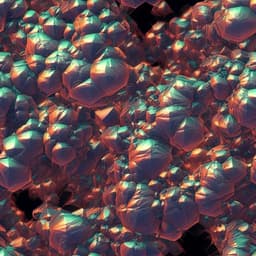
Physics
Imaging and structure analysis of ferroelectric domains, domain walls, and vortices by scanning electron diffraction
U. Ludacka, J. He, et al.
This groundbreaking research, conducted by a team of experts, unveils the extraordinary potential of direct electron detectors in scanning transmission electron microscopy. By employing a custom convolutional autoencoder, the authors investigate polar distortions in the uniaxial ferroelectric Er(Mn,Ti)O₃, delivering unmatched quantitative insights into nanoscale structural changes across vast areas. Prepare to be amazed by their discoveries of intricate domain dynamics and topological formations!
~3 min • Beginner • English
Introduction
The study addresses how to quantitatively image and analyze symmetry-breaking nanoscale structural distortions in functional materials using 4D-STEM. High-energy electrons are highly sensitive to local structure, electric and magnetic fields, and chemistry, and direct electron detectors (DEDs) have enabled four-dimensional STEM (4D-STEM) with high information density. However, the complexity of dynamic scattering, multiple coexisting contrast mechanisms, and varying signal-to-noise levels hinder straightforward, model-based interpretation. The authors propose using scanning electron diffraction (SED) combined with a custom convolutional autoencoder (CA) to statistically disentangle weak yet informative scattering signatures associated with ferroelectric domains, domain walls, and vortices in Er(Mn,Ti)O₃. The purpose is to achieve simultaneous nanoscale imaging and local structure analysis, separating intrinsic structural signals from extrinsic effects such as thickness or bending, and to provide a generalizable pathway for quantitative structure-property correlation and automated experiments.
Literature Review
The paper situates the work within advances in TEM and 4D-STEM enabled by high dynamic-range DEDs, which capture full diffraction patterns at each probe position, greatly increasing information density. Prior work has leveraged 4D-STEM for phase contrast, strain mapping, and quantifying weak scattering, but interpretation is challenged by dynamic scattering and incomplete empirical models. Machine learning has been increasingly used in microscopy for data reduction, segmentation, automated experiments, and disentangling multimodal nanoscale spectroscopic signals with statistical significance. Conventional approaches like β-VAEs impose Gaussian priors that can reduce interpretability and be ill-suited for intrinsically non-Gaussian, sparse features such as domain walls. Recent developments motivate custom architectures and regularization strategies to disentangle geometric transformations and structural features without unphysical priors, providing a foundation for the CA used here.
Methodology
Materials and specimen preparation: High-quality single crystals of hexagonal Er(Mn₁−xTiₓ)O₃ (x = 0.002) were grown by the pressurized floating-zone method. Crystals were oriented by Laue diffraction and cut perpendicular to the polar axis (P ∥ [001]), chemo-mechanically polished to ~1 nm RMS roughness, and characterized via SEM/PPFM. Electron-transparent lamellae were prepared from pre-characterized regions using a Thermo Fisher G4 UX DualBeam FIB with protective electron- and ion-beam-deposited carbon layers, trench milling and lift-out, followed by progressive thinning (9 nA to 90 pA), and final low-energy polishing (2 kV, 0.11 nA) to remove damage.
4D-STEM acquisition: Experiments used a JEOL 2100F TEM at 200 kV with a Nanomegas P1000 scan engine and a Quantum Detectors Merlin 1S direct electron detector (lower threshold 40 kV). Probe: 2 nm diameter, 9 mrad convergence. Scan grid: 256 × 256 positions with 1.4 nm step, 50 ms dwell per position, yielding a 4D dataset (diffraction pattern per probe). STEM imaging used nanobeam diffraction mode with a 10 µm aperture and 4.6 pA probe current. Virtual dark-field (VDF) images were formed by integrating intensity over selected reciprocal-space regions per Meng and Zuo.
Center-of-mass (COM) analysis: For each diffraction pattern, the COM was computed to assess momentum shifts indicative of internal fields. Spatial maps and reciprocal-space distributions were compared between +P and −P domains to reveal domain-dependent scattering asymmetry along crystallographic [001].
Convolutional autoencoder (CA): The CA was implemented in PyTorch. Input diffraction patterns (log-intensity transformed) of size 256×256 were encoded through three ResNet-based blocks with downsampling (256→64→16), a convolution with one filter, flattening, and a dense embedding layer; non-negativity enforced via ReLU. The decoder comprised a dense layer, convolutional layers, and three upsampling ResNet blocks (8→16→64) culminating in a reconstruction layer. Total learnable parameters: ~4.7M. Training used ADAM optimizer (typical learning rate 3×10⁻⁵) minimizing MSE reconstruction loss plus custom regularization.
Regularization and disentanglement: Sparsity via L₁ activity regularization on the embedding with coefficient λ_act (scheduled to tune sparsity). To better capture rare features (domain walls), two additional terms were used: (i) contrastive similarity regularization L_sim based on cosine similarity of non-zero embedding vectors within a batch (λ_sim) to encourage dissimilarity among non-sparse vectors; (ii) activation divergence regularization L_div (λ_div) to promote embeddings with dominant components, enhancing interpretability. ReLU ensured non-negative activations.
Training protocols: For dataset DS1 (two domains): λ_act = 1×10⁻⁵, ADAM, 377 epochs; overcomplete embedding size 32 with 9 active channels post-training. For DS2 (vortex): λ_act = 1×10⁻⁵ for 225 epochs, then λ_act = 5×10⁻⁴ for 60 epochs with learning-rate cycling (3×10⁻⁵ ↔ 5×10⁻⁵). For domain-wall-focused embeddings: L₁ with λ₁ = 5×10⁻³, plus L_sim = 5×10⁻⁵ and L_div = 2×10⁻⁴ for 18 epochs (ADAM, 3×10⁻⁵). Channel-wise activation maps were used as virtual apertures: mean diffraction patterns were computed from the top/bottom 5% activation quantiles to visualize domain- or wall-specific scattering differences.
Simulations: Multislice simulations (Python-based) generated diffraction patterns for +P and −P domains of Er(Mn,Ti)O₃ (example thickness 75 nm). Normalized cross-correlation Δ(+P,−P) maps identified reflections with the strongest domain-dependent variations and were compared to experimental Δ maps.
Analysis targets: Identify and image ±P domains, extract domain walls, distinguish charge states (head-to-head vs tail-to-tail), and map vortex-like sixfold meeting points. Disentangle intrinsic structural signals from extrinsic effects (thickness, bending, scan bias). Spatial resolution was limited by the ~2 nm probe size.
Key Findings
- Domain-dependent scattering: COM analysis across DS1 revealed a substantial shift of diffraction pattern COM along [001], splitting between +P and −P domains and co-locating with VDF-resolved domain structure.
- CA disentanglement: A single embedding channel sharply separated 180° domains; other channels captured extrinsic variations (thickness, bending, scan geometry) and domain-wall-specific features. Overcomplete embedding (32) reduced to 9 active channels post-training, indicating sparse, interpretable representations.
- Reciprocal-space signatures: CA-derived mean diffraction patterns for +P and −P showed pronounced asymmetry in reflections along [001], especially 004/0̄04 and, to a lesser extent, 002/0̄02. The specific intensity distributions varied with specimen thickness.
- Simulation agreement: Multislice simulations at 75 nm thickness reproduced asymmetric 004/0̄04 intensities and Δ(+P,−P) maps that matched experimental data, confirming sensitivity to the up-up-down vs down-down-up Er displacement patterns and associated polarization.
- Domain walls and vortices: In DS2, the CA resolved a sixfold vortex of alternating ±P domains. Separate embedding channels isolated two wall types: positively charged head-to-head and negatively charged tail-to-tail walls, evidencing sensitivity to both crystallographic structure and bound charge at walls.
- Virtual aperturing via activations: Using activation quantiles as selection masks enabled generation of difference patterns that emphasized domain- and wall-specific reflections without creating artificial components.
- Spatial resolution and robustness: Real-space imaging of domains, walls, and vortex cores was achieved with nanoscale resolution limited by the 2 nm probe, with statistical separation of intrinsic signals from extrinsic factors.
Discussion
The findings demonstrate that 4D-STEM combined with a custom-regularized CA can quantitatively disentangle weak, symmetry-breaking structural signatures at the nanoscale in a ferroelectric model system. By mapping domain-dependent COM shifts and selectively enhancing domain-specific reflections (004/0̄04, 002/0̄02), the approach ties diffraction contrast directly to polar distortions and atomic displacement patterns. The CA’s sparse, non-negative embedding separates intrinsic structural variations from extrinsic thickness and bending effects, enabling statistically robust identification of ferroelectric domains, domain walls, and vortex structures in a single experiment. Importantly, distinct embedding channels correspond to head-to-head vs tail-to-tail wall charge states, linking scattering to bound charge and local electrostatics. This capability addresses the challenge of overlapping contrast mechanisms in dynamic diffraction and paves the way for improved structure–property correlation, scaled mapping across large fields of view, and integration into automated, high-throughput experimental workflows.
Conclusion
This work establishes a pathway for simultaneous nanoscale imaging and structural deconvolution in ferroelectrics using SED/4D-STEM coupled to a custom convolutional autoencoder with tailored regularization. The method statistically disentangles intrinsic scattering signatures of ±P domains, domain walls, and vortex cores from extrinsic artifacts, corroborated by multislice simulations. It enables quantitative mapping of symmetry-breaking distortions with spatial resolution limited by the probe size (~2 nm) and is broadly applicable to high-dimensional imaging in other materials systems. Future work can extend to larger imaging areas and higher frame rates, incorporate active feedback for automated experiments, and apply the framework to discover and classify defects, secondary phases, and other weak scattering features across diverse quantum and functional materials.
Limitations
- Dependence on specimen conditions: Diffraction intensity distributions (e.g., 004/0̄04 vs 002/0̄02) vary with thickness and local bending, requiring dataset-specific interpretation and potentially limiting direct quantitative comparison across samples without thickness calibration.
- Model per dataset: The CA is trained per experiment/imaging condition; generalization across datasets without retraining is not established.
- Regularization tuning: Effective disentanglement, especially of rare features like domain walls, required custom regularization scheduling and hyperparameter tuning, which may be nontrivial and data dependent.
- Resolution bound: Spatial resolution is limited by the probe size (~2 nm) and scan step, potentially missing sub-nanometer features.
- Dynamic scattering complexity: Despite improvements, fully interpretable deconvolution of all dynamic scattering contributions remains challenging, and simulations require assumed thickness and structure parameters.
Related Publications
Explore these studies to deepen your understanding of the subject.







